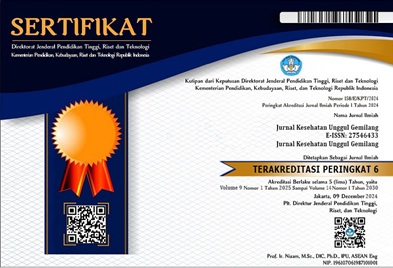FAKTOR – FAKTOR YANG BERHUBUNGAN DENGAN KEJADIAN BAYI BERAT LAHIR RENDAH (BBLR) DI RSUD KH. MANSYUR KINTAP KABUPATEN TANAH LAUT TAHUN 2024
Kata Kunci:
Bayi Berat Lahir Rendah (Bblr), Faktor Risiko, KehamilanAbstrak
Latar Belakang : Kejadian Bayi Berat Lahir Rendah (BBLR) masih menjadi masalah serius secara global, termasuk di Indonesia, dengan risiko kematian dan komplikasi jangka panjang bagi bayi. Faktor utama yang memengaruhi BBLR meliputi usia ibu, tingkat pendidikan, paritas tinggi, status gizi, dan preeklampsia selama kehamilan. Tujuan : Mengetahui faktor-faktor yang berhubungan dengan kejadian Bayi Berat Lahir Rendah (BBLR) di RSUD KH. Mansyur Kintap Kabupaten Tanah Laut Tahun 2024. Metode Penelitian : Penelitian ini bersifat kuantitatif dengan desain survei analitik retrospektif, peneliti mengisi ceklist berdasarkan informasi yang didapatkan dari laporan register dan buku rekam medik di RSUD KH. Mansyur tahun 2024, pengambilan sampel kontrol dalam penelitian ini menggunakan Sistematic Random Sampling yang berjumlah 82 ibu (sampel control) dan 82 ibu (sampel kasus). Analisis data dilakukan secara statistik menggunakan uji chi-square. Hasil Penelitian : Sebanyak 82 bayi (50,0%) mengalami BBLR, dengan ibu hamil berisiko usia 86 (52,4%), pendidikan menengah 115 (70,1%), paritas tidak berisiko 124 (75,6%), dan preeklampsia 46 (28,0%); terdapat hubungan signifikan antara usia (p=0,016), paritas (p=0,018), preeklampsia (p=0,000) dengan BBLR, namun tidak terdapat hubungan dengan tingkat pendidikan (p=0,726) di RSUD KH. Mansyur Kintap Kabupaten Tanah Laut Tahun 2024. Kesimpulan : Kejadian BBLR di RSUD KH. Mansyur Kintap Kabupaten Tanah Laut Tahun 2024 dipengaruhi oleh usia, paritas, dan preeklampsia ibu hamil (p<0,05), namun tidak dipengaruhi oleh tingkat pendidikan (p=0,726).
Background: The incidence of low birth weight (LBW) remains a serious global problem, including in Indonesia, with a risk of death and long-term complications for infants. The main factors influencing LBW include maternal age, education level, parity, nutritional status, and preeclampsia during pregnancy. Objective: To determine factors associated with the incidence of low birth weight (LBW) at KH. Mansyur Kintap Regional General Hospital, Tanah Laut Regency in 2024. Methods: This quantitative study used a retrospective analytical survey design. Researchers completed a checklist based on information obtained from register reports and medical records at KH. Mansyur Regional Hospital in 2024. Systematic random sampling was used to select 82 mothers (controls) and 82 mothers (cases). Data were analyzed statistically using the chi-square test. Results: A total of 82 infants (50.0%) experienced LBW, with 86 (52.4%) at-risk pregnant women, 115 (70.1%) with secondary education, 124 (75.6%) with parity and 46 (28.0%) with preeclampsia. There was a significant association between age (p=0.016), parity (p=0.018), and preeclampsia (p=0.000) with LBW, but no association was found with education level (p=0.726) at KH. Mansyur Regional Hospital. Mansyur Kintap Hospital, Tanah Laut Regency, 2024. Conclusion: The incidence of low birth weight (LBW) at KH. Mansyur Kintap Hospital, Tanah Laut Regency, in 2024 was influenced by maternal age, parity, and preeclampsia (p<0.05), but not by education level (p=0.726).






